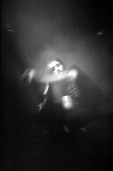Slow Club
It’s called indie pop for a reason.
Because it’s pop. And because it’s indie.

It’s a niche. It isn’t much on TV or national radio to break into everyone’s home.
You need to search for it. You need to desire it.
The only mainstream media to talk about independent music, and only in England, are national newspapers.

Only recently, thanks to streaming platforms, papers became multimedia channels to offer listening in addition to the traditional articles with photos.
The Guardian streamed Slow Club third album, Complete Surrender, before its official release. The newspaper capability to permeate the ethereal atmosphere of the internet managed to bring the band in many more homes including mine.
Slow Club aren’t new to the niche. They still are to the masses.

The first album, Yeah So, was out in the summer of 2009 (5 years is a long time in today’s music average band lifetime).
The album opens with When I Go a delicate country-ish lullaby and goes on with Rebecca Taylor and Charles Watson multi-instrument playing along those melodic lines.

A Christmas EP followed the end of the same year, Christmas Thanks For Nothing. It was not a weird choice. Rebecca voice sounds perfect for a Christmas album. Big, deep, sound. Curiosity made me play Silent Night on Spotify on the warmest day of the year to discover it is an instrumental! The rest of the EP covers Darlene Love and has a couple of originals that, to be fair, are better than the covers.

At this point of their career Slow Club were still looking for a musical identity. I would classify them more among the indie-folk brigade together with the Laura Marling, First Aid Kit and the other girls that grew up with Mum’s Jony Mitchell vinyls.
Rebecca potential still has to come out powerful as it will be.

2011 arrived and Paradise, their second LP, came out late summer. From the first song the message sounds clear. Slow Club are moving to bigger songs. Arrangements gets more elaborate, rhythm is prominent and Taylor’s voice is finding her natural space and place.
A place which is not anymore in the folk tradition but not yet in a soul filled indie-pop.
Paradise deserved all the very good reviews it had worldwide, and in the indie-music blogosphere the band is now well known. They are played to a thousand people in the lovely London Koko to put them in contest.
At this point I haven’t seen them yet. I am much quicker to get in touch with rockier, garage, noisy new bands than more melodic, new-romantics.
But I get there in the end.

3 more years, another summer and another Slow Club album arrives: Complete Surrender. From the cover it’s clear this is a different thing. The colourful painting of Paradise is replaced by an almost monochromatic photo.
This is the piece that marks the division between two eras.
Change of label, they moved from Moshi Moshi to bigger indie Wichita, but most important they moved their sound to a contemporary indie version of Northern soul.
It does fit very well in the definition of blue-eyed soul for obvious reason but I would be unfair to Charles Watson.

Slow Club started as a duo and Charles Watson has an essential part in taking the band music to their sound, never drifting into clichés.
Both Charles and Rebecca are multi-instrumentalist and they alternate between guitar, keys and vocals. Rebecca plays drums too. I like when musicians move to their favourite instrument for a particular song. I imagine them composing music on a particular instrument and going back to that once in concert.

I arrive to the Portland Arms in Cambridge, delighted to see them in such a tiny venu. I know regret I sent my 14-24mm to service due to Deap Vally guitarist kicking it off stage and blocking the zoom ring at a gig the night before this.
One of the reasons that brought me to this show was a Rebecca Taylor interview at TLOBF where she gives her tips for dating.
It emerges an open, sincere, honest personality. Strong and at the same time fragile. The kind of frankness I love.

I get the same impression from the show. New songs have her voice stepping out and imposing itself over the band and the audience. Incredible performance that is rare to find nowadays. Suddenly Rebecca steps back, sit at the drums or at the keys. She hides behind the microphone, almost wispers, leaves space to Charles in a presence that is as essential as it is unobtrusive.

Indie fans love feeling the artist close to them. To be “one of them”. Slow club are indie to heart. Rebecca is inches from the fans, she chats, she asks for an elastic to tie her hair in the super hot room. She get one from ‘Fiona’ a girl in the audience that passes her a rubber band. She’ll then acknowledge Fiona when presenting the band. It all comes naturally and it is lovely.
She introduced the band. Indeed. Slow Club are a quartet on stage. Watson and Taylor keep control but are joined by a rhythm session, drummer and bassist at the beginning before they start exchange instruments depending on the songs’ need.

Expectedly the show rotates around the latest album (A pic of the setlist is here). They started with a couple of oldies but the new songs point to a different direction and the bands has more than a reason to emphasise them. Most of the album will be played and among my favourites The Queen’s Nose sounds as a soul classic, revisited for the third millennium. Number One is a powerful slow ballad where Charles singing finds a perfect place in the harmonics with Rebecca tapping in.

As it always happens when bands change directions (Bob Dylan anyone?) there will always be someone disappointed. It’s the artists the first that have to believe in what they do, and Slow Club ‘convinced me they are convinced’. They wants to bring their sound in everyone’s home. Together with the genuine approach of two young guys that believe in their songs.
Very much worth catching them live now, unless you like big shows in huge theatres in the next years.
For everything else there is internet: [website][facebook][twitter][Spotify]

Photo tip
So it is possible! So there are wise bands out there.
LED lights have been concert photographers’ nightmare in the past five and more years. They replaced most complaints that were dedicated to red spotlights.
Camera sensors never dealt well with red and too often B&W stopped being an aesthetical decision to become a technical necessity.

Since the LEDs arrived I almost wish for the red lights. LEDs are very cheap to run, give a variety of effects and many small venues have them as standard lighting. As the Portland Arms.
If they are set to a single colour from blue to red through purple, photos are going to have serious problem of sensor saturation as last photo in this post here.
It becomes again a B&W necessity with load of toning of saturation/hue/luminosity levels on the separate colour channels.

Slow Club showed you can set LEDs set to a more neutral colour that won’t make photography job impossible. For the beginning of the set light was good enough (still not enough) to shoot. Than it turned monochromatic for a bit, rotating all colours for another while and in the end stopped on a too pink tone but still this was enough for some photos.
If you are a band, and you want good photos of your show, tell the light technician to add enough green/yellow/orange to the LEDs to counterbalance the purple/red/blue.
It doesn’t have to be forever… give us at least three songs.








